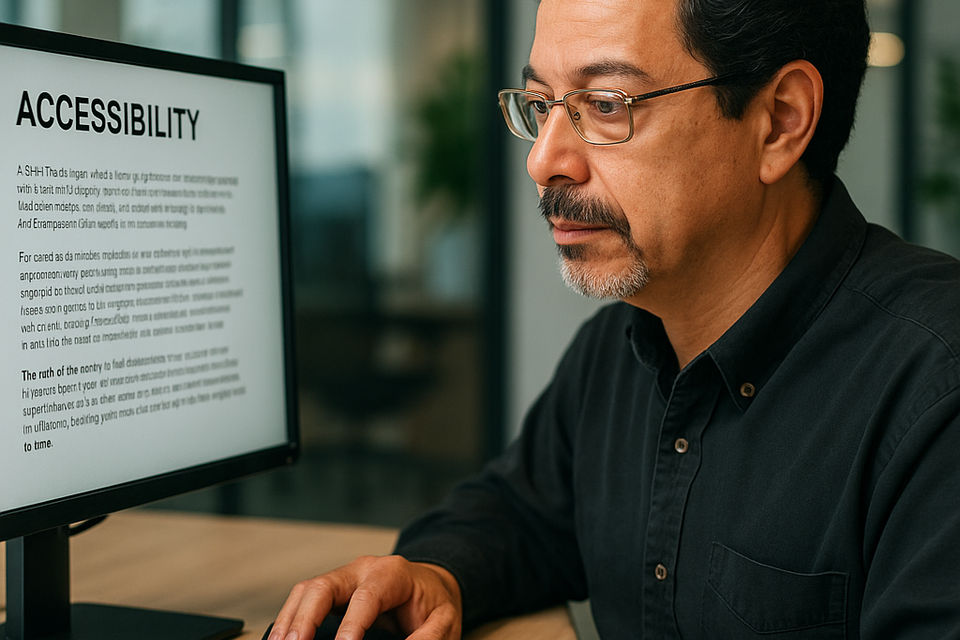What I Wish I Knew About Accessibility Before the Layoffs
How a skill I learned decades ago became the cornerstone of my future.
When the recent round of federal layoffs hit, I watched some incredibly talented colleagues walk out the door. I was among them. While I had prepared myself mentally and financially, the moment still stung. It always does.
But as the dust settled, one thing became clear: I had something solid to stand on. A skill I’d been developing quietly in the background for more than two decades—digital accessibility—was now front and center.
Accessibility: A Skill Forged in Real-World Experience
My introduction to accessibility didn’t come from a workshop or a YouTube tutorial. It started in the early 2000s with a simple memo.
At the time, I was working as a contractor within the federal government when we were informed that all websites under our management had to become “508 compliant.” No further explanation. Just a clear directive: Make it compliant.
So I dug in. I studied the W3C’s evolving guidelines, read everything I could get my hands on, and tapped into the collective wisdom of accessibility advocates who were already charting the course. I also had the good fortune of learning directly from one of the field’s most respected pioneers—someone who not only helped write the book on 508 compliance but also trained web developers across the agency. His mentorship shaped how I approached the task ahead.
Back then, I was managing ten federal websites. My job was to audit, test, and remediate each one—page by page. It wasn’t glamorous work, but it was meaningful. I was learning how people with disabilities experienced the web—and how small changes in structure, code, and content could make a huge difference.
What I’ve Learned Since Then
Over the years, accessibility has matured—but the need has only deepened. Here’s what I wish more people understood: - Accessibility is not a trend—it’s a responsibility. The standards may evolve, but the goal remains the same: build digital spaces that work for everyone.
- It’s cross-disciplinary. You don’t have to be a developer. Writers, designers, analysts, project managers—all play a role in accessibility.
- The risk is real—and rising. Legal actions over inaccessible websites are growing. Organizations can no longer afford to treat accessibility as an afterthought.
- It’s also good business. Accessible websites are faster, rank better, and provide a smoother user experience for everyone.
From Reduction in Force to Renewed Focus
After I left government service, I leaned into the momentum I’d already built. I founded 508 Help Desk, a consultancy focused on helping organizations improve digital accessibility through audits, remediation, strategic guidance, and support.
But let me be clear: this wasn’t a fallback plan. It was the natural next step of a journey I began years ago.
That said, I know the most meaningful impact often happens from within. That’s why I remain open to collaborating with government agencies, enterprise teams, and mission-driven organizations that are serious about improving accessibility. Whether through contracts, partnerships, or dedicated roles—my goal is to help bring clarity, compliance, and real usability to digital platforms that serve the public.
Want to Get Started in the Industry? You Don’t Have to Be an Expert
If you’re exploring accessibility for the first time—or simply want to increase your value in today’s evolving workplace—here are a few places to begin: - Start with WCAG. Begin with WCAG 2.1 and focus on the four pillars: Perceivable, Operable, Understandable, and Robust (POUR).
- Run a quick scan. Free tools like WAVE, Axe, and Lighthouse can show you accessibility issues on your site right now.
- Follow accessibility leaders. The community is active, generous, and always teaching. LinkedIn and YouTube are great places to stay current.
Final Thought: The Opportunity Is Now
Accessibility is no longer optional—not for government agencies, not for enterprise organizations, and not for any business hoping to stay relevant in a digital-first world.
If you’ve been laid off, reassessing your skills, or just looking for new ways to add value—learning accessibility may be the smartest move you can make.
I started learning it because I had to. I continue learning it because I believe in it. And now, I help others see it for what it really is:
A bridge to better digital experiences—for everyone.


